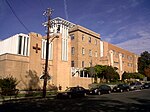Takoma Park Historic District (Takoma Park, Maryland)

The Takoma Park Historic District is a national historic district located at Takoma Park, Montgomery County, Maryland. The district area was platted in 1883 by developer Benjamin Franklin Gilbert, and promoted for its natural environment and healthy setting. Originally an early railroad suburb, the opening of streetcar lines led to the expansion of the district in the early 20th century. Takoma Park houses built between 1883 and 1900 are fanciful, turreted, multi-gabled affairs of Queen Anne architecture with Stick Style and Shingle Style influence. Buildings developed after the turn of the 20th century tend to be 1-2 story brick structures with simple ornamentation, although a few display characteristics of such styles as Art Deco and Tudor Revival.It was listed on the National Register of Historic Places in 1976.
Excerpt from the Wikipedia article Takoma Park Historic District (Takoma Park, Maryland) (License: CC BY-SA 3.0, Authors, Images).Takoma Park Historic District (Takoma Park, Maryland)
Maple Avenue,
Geographical coordinates (GPS) Address Nearby Places Show on map
Geographical coordinates (GPS)
| Latitude | Longitude |
|---|---|
| N 38.978055555556 ° | E -77.012777777778 ° |
Address
Maple Avenue 7216
20912
Maryland, United States
Open on Google Maps










